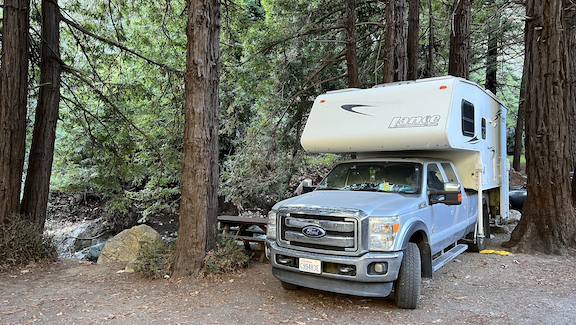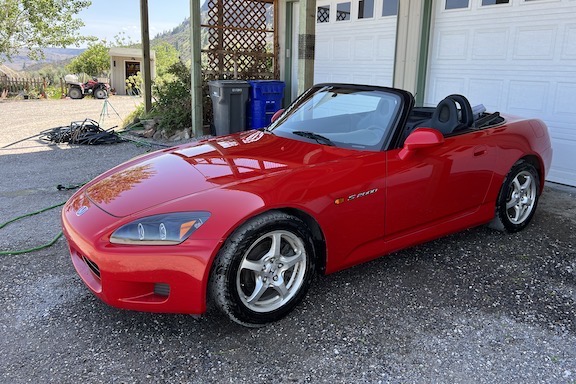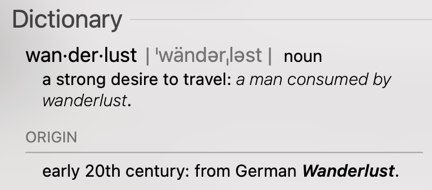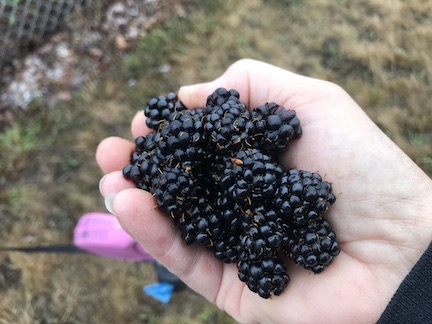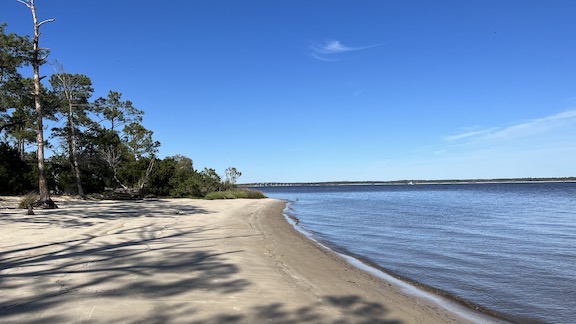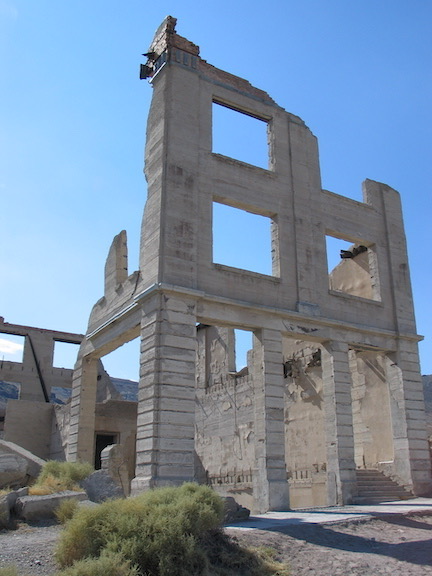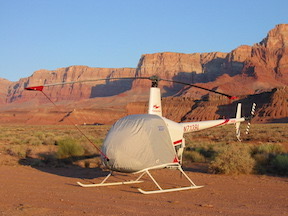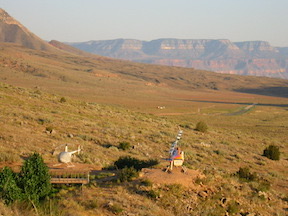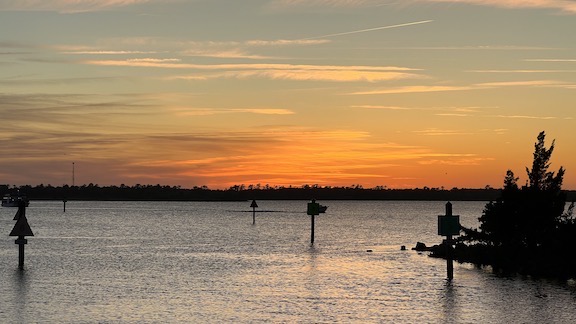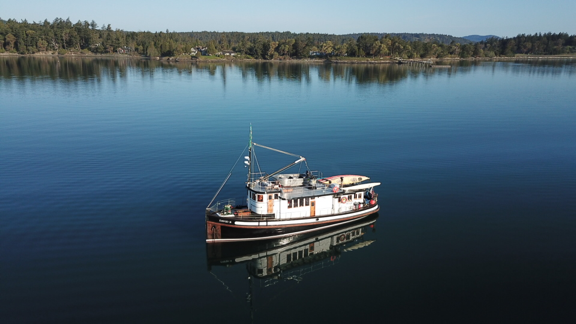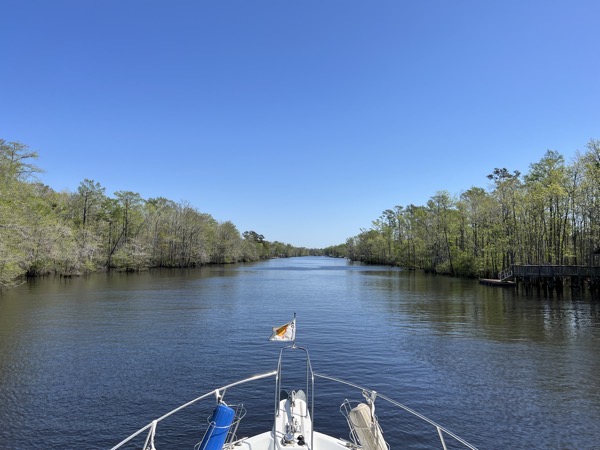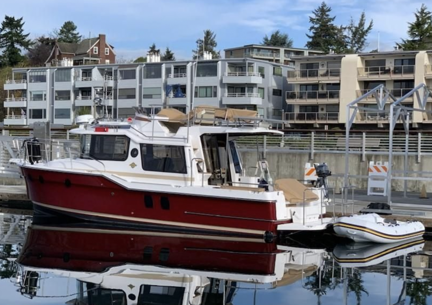I finish my Great Loop trip and jump through all necessary hoops to get my boat back to Washington State, battling covid along the way.
If you’ve been following this blog or my Great Loop trip blog, you know that since October 2022 I’ve been cruising with my boat, Do It Now, along the Great Loop. You can learn more about the trip in that blog.
I finished the trip — or “crossed my wake” — on August 12, 2024. That was in Chicago, IL, which is where I began the trip. I’d had my boat shipped out there from Olympia by a boat shipping company. Since then, I’d bought a boat trailer for it and planned to haul it back to Washington myself. This would be a 3 part (or)deal: fly home with my pups, haul the empty trailer back to the Chicago area (2000 miles), and haul the boat back to Puget Sound (2150 miles).
Chicago to Malaga
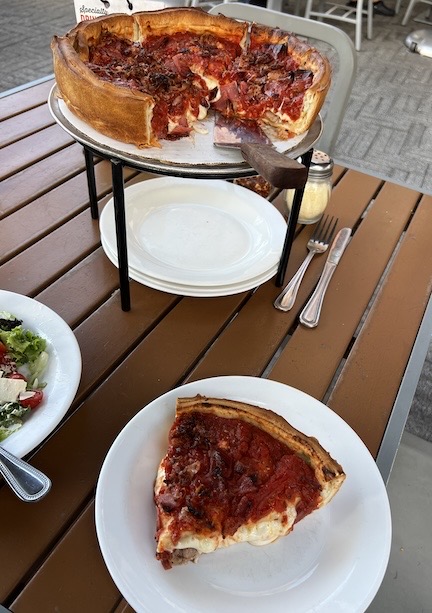
Deep dish pizza at the Navy Pier. I was a total tourist.
I spent Monday and Tuesday in Chicago taking care of personal chores. I needed an eye exam and my pups needed grooming. I had Chicago deep dish pizza, which I really like.
On Wednesday, I cruised to Waukegan, where I planned to have the boat hauled out when I returned with the trailer. When I arrived, I was pretty sick with classic flu-like symptoms. I took a Covid test and, for the first time ever, got a positive result.
Shit.
I flew home (masked) with Covid on Thursday. I got a prescription for Paxlovid that cost a small fortune. Because my housesitter would be living in my house until month-end, I stayed in my truck camper in the garage. It was comfortable. The air conditioning worked great and was needed. The new garage bathroom was very good.
I spent a lot of time sleeping. My body clock got completely screwed up. NyQuil became my evening elixir, helping me sleep.
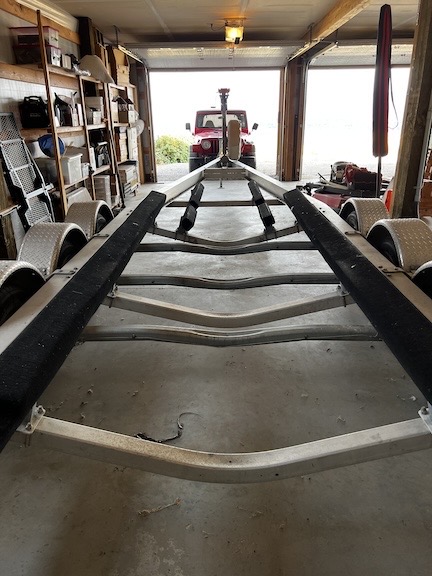
I used my Jeep to get the trailer out of the garage.
On Monday, I felt good enough to get the boat trailer out of the garage. I needed to use the Jeep, which has a hitch on the front. I honestly don’t know how I got it in there — I had a heck of a time getting it out. Then I packed the truck with the things I’d need to come home, including the “Oversize Load” banners and a long tape measure.
I still tested positive for Covid.
On Tuesday morning, I was ready to go. I’d decided to stop and have my local trailer guy check things over before I left. I showed up there at 7:30 AM. He looked it over and found some problems with wheels and one of the brakes. I kicked myself for not bringing it by sooner, then unhitched it, left it with him, and went home.
Driving East
On Wednesday morning, still testing positive for Covid, I went to pick up the trailer and start the 2,000 mile trip to Waukegan. I would take I-90 almost all the way. It would give me an opportunity to review the route before I headed west with the boat in tow.
The boat trailer is about 36 feet long. It’s a bumper pull so wide turns are required. I fueled up with the big rig truckers at truck stops.
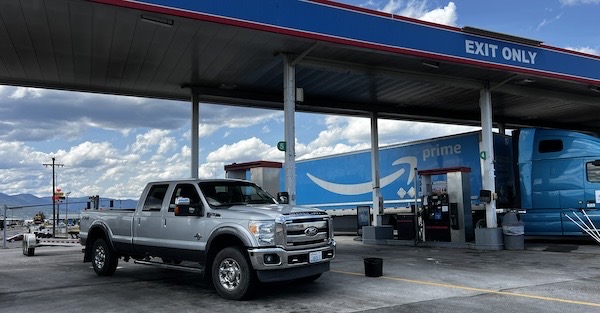
I fueled at truck stops.
My dogs and I stayed at crappy cheap motels along the way. Covid was a definite issue; I still had plenty of symptoms and was exhausted at the end of each day. We’d get to the hotel, I’d walk my pups, I’d drag my luggage in, I’d feed my pups, I’d walk them again, and then we’d all go to bed, usually before 8 PM.
In the morning, I’d wake before dawn. When it got light, I’d feed and walk my pups and then put them in the truck. If the motel offered breakfast, I’d choke down some cooked powered eggs and greasy sausage. Then I’d go back to my room, get my luggage, drag it back to the truck, and leave.
I got decent mileage — about 15 mpg. I was fueling once or twice a day, getting at least 500 miles behind me each day.
On Saturday, when I got close, I stopped at a Discount Tire to get my truck’s tires rotated and the trailer tires checked and properly inflated. The trailer tires had plenty of tread, so I figured they’d be fine.
I stopped at a Walmart supermarket for provisions.
At Waukegan
We arrived at the boat yard in Waukegan on Saturday afternoon. The yard was closed. Fortunately, I had a key card from my previous stay that opened the gate.
I spent the weekend prepping the boat to be hauled — all the canvas and the mast and antenna had to be taken down and any seat covers had to be secured. It was brutally hot — there was a heat wave in the Chicago area — and I could only work in short bursts with rest and cool-down periods in between. It took all day Sunday to get the boat 90% ready. I’d take care of the other 10% on Monday morning.
I ordered my Oversize Load permits on Sunday. The woman at JJ Keller who helped me was not the sharpest knife in the drawer. She asked me dumb questions, insisted I needed a DOT number that I didn’t need, and then gave me misinformation about my route. But the permits started arriving via email the first thing Monday morning.
I was still testing positive for Covid, although my symptoms had faded to just a cough.
On Monday, around midday, they hauled the boat out and put it on the trailer. That was a fiasco. The trailer, which had originally hauled someone else’s much older R-29, had the bunkers set up for a different hull configuration. It took the guys at the marina three hours to figure that out. In the meantime, we kept launching and retrieving the boat on the boat ramp. The bow of the boat struck the front of the trailer frequently enough to cause some damage to the gelcoat.
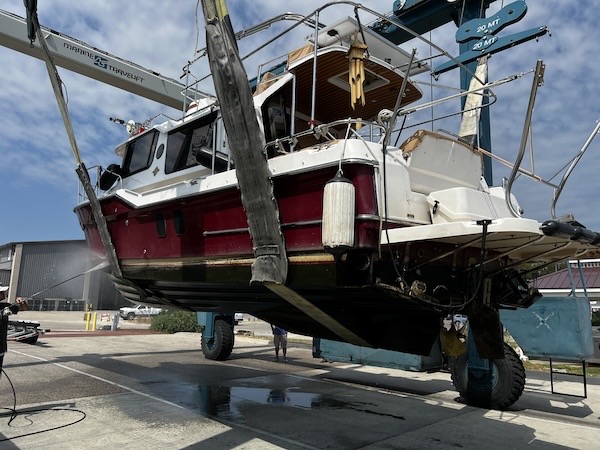
They started out okay, using the Travelift to pull the boat out.
Finally, by 4 PM, the boat was secure on the trailer. Of course, it was too late for me to leave so I wound up spending the night in the boat, parked on the ramp in front of the marina.
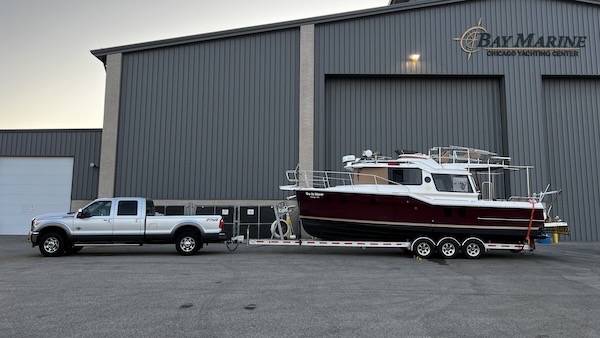
It took all afternoon to get the boat on the trailer and it still wasn’t quite right.
I took a cool shower to cool down before going to bed. I didn’t care that the water splashed out onto the asphalt in front of the building.
Driving West
I got underway at sunrise on Tuesday morning. I was still testing positive for Covid, but I was feeling much better. The only symptom was a cough that came and went. There wasn’t even that much phlegm.
I went through my first weigh station less than 10 miles from my starting point. I rolled onto the scale and a voice came through a loudspeaker, asking if I was hauling the Minnow from Gilligan’s Island. I told him I hoped not. The light turned green and I rolled out.
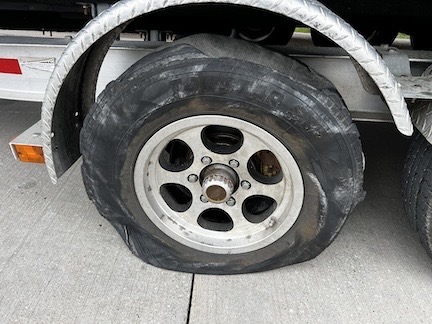
One flat gave me the idea I was towing a time bomb.
I got a flat tire on the trailer four hours into the drive. Fortunately, BoatUS sent out a tire change guy for me. He pointed out that although the tread looked fine, the tires were six years old. I suddenly felt as if I were towing a time bomb. How long before another tire blew? So rather than just get the spare replaced, I drove directly to a Discount Tire an hour away and had all six trailer tires replaced.
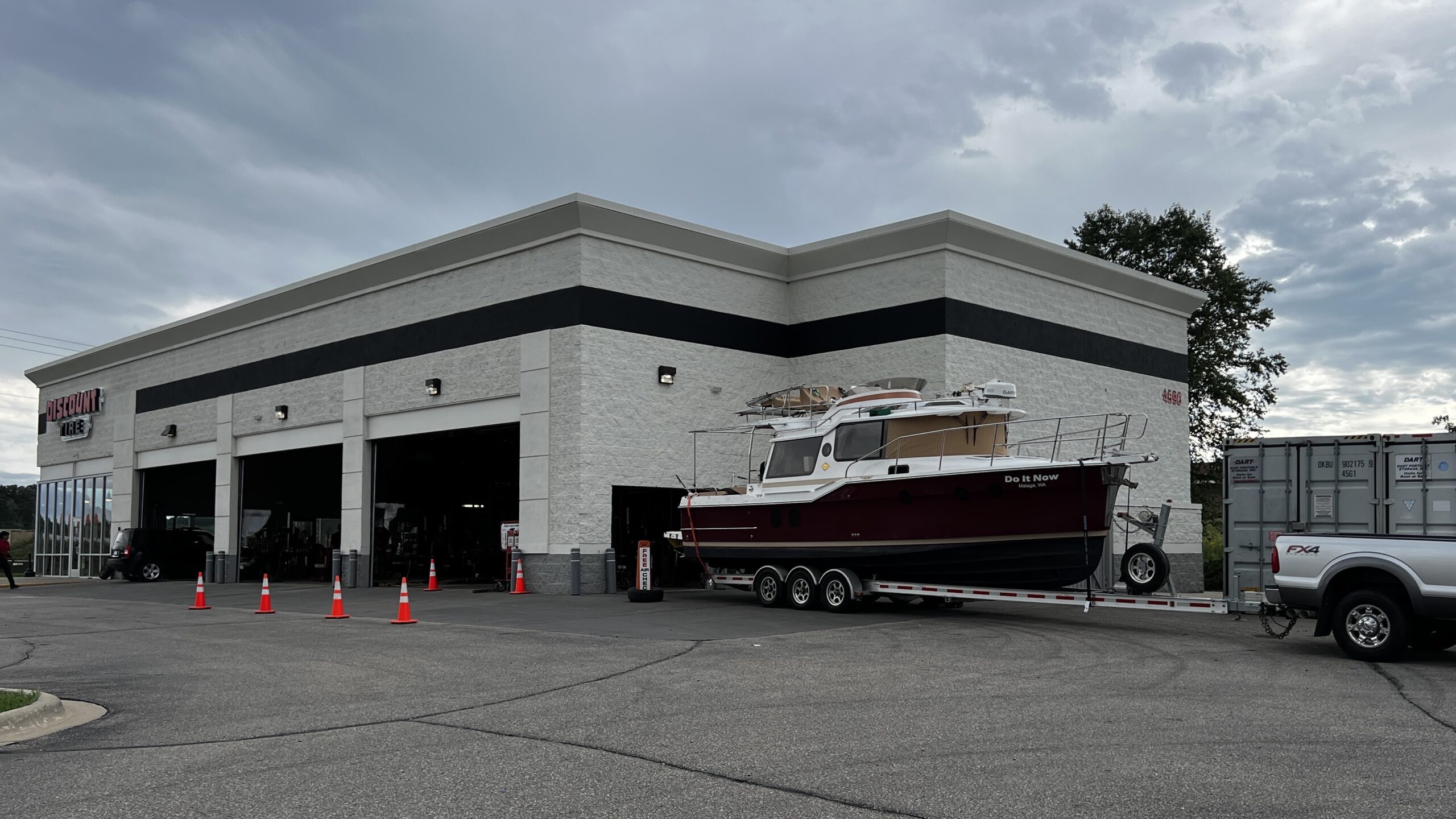
My rig couldn’t fit into the garage at Discount Tire.
I spent the first night at a truck stop in Rapid City, SD. I arrived after sunset and the place was jam packed. By some miracle, I was able to back my rig into a narrow semi parking spot. I still can’t believe I did it after the day I’d had.
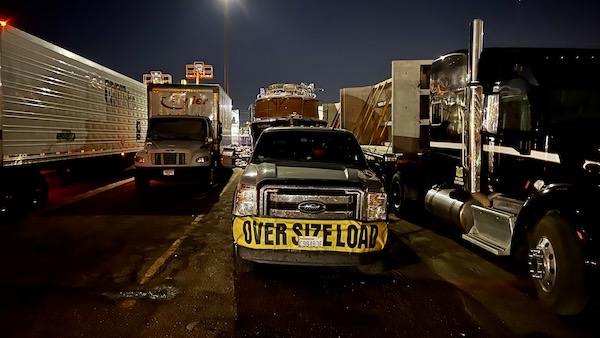
I can’t believe I parked here.
In the morning of Day 2, it was very foggy. I didn’t get started until almost 10 AM.
Later, while climbing a steep hill in hot weather, the Check Engine light went on. The truck seemed to drive okay, but I started rethinking the route the idiot at JJ Keller had given me. Because Google Maps takes people off I-90 and onto US 212, a slightly shorter route through the Crow Indian reservation, before rejoining I-90, I would be away from the Interstate for several hours. I had been on Route 212 before and I knew that there were very few facilities along the way. If the truck decided to die, dying on that route would not be optimal. So I decided to ignore the route and stay on I-90, even though my permits said I’d be on US 212.
Of course, that caused raised eyebrows at a truck weight station I did need to get out at in Wyoming. Although I’d purchased my permit the day before — it was the only state JJ Keller couldn’t buy the permit for — my permit showed the wrong route. I explained my dilemma and the folks there just updated my permit with the new route and sent me on my way.
I pulled into a watercraft inspection station in Wyoming near the end of the day and waited while they inspected the hull and bilge. (For the record, I’d had the hull power washed and bilge cleaned when it was taken out of Lake Michigan.) They didn’t find anything, but they wanted to attach a hose to my engine water intake and have me run the engine. I said no. I told them there was no way that I’d start an engine that cost $25K to $40K to replace unless the boat was in the water. They were fine with that.
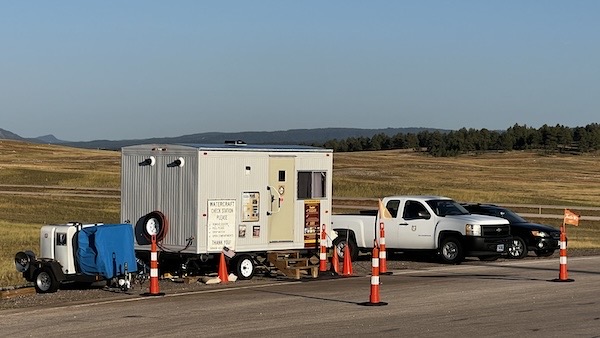
The first watercraft inspection station I stopped at was in Wyoming.
But by the time they’d finished searching the boat, it was too late to get to my destination 150 miles away. The rest area where they’d inspected me was very nice so I just spent the night there. It was wonderfully quiet.
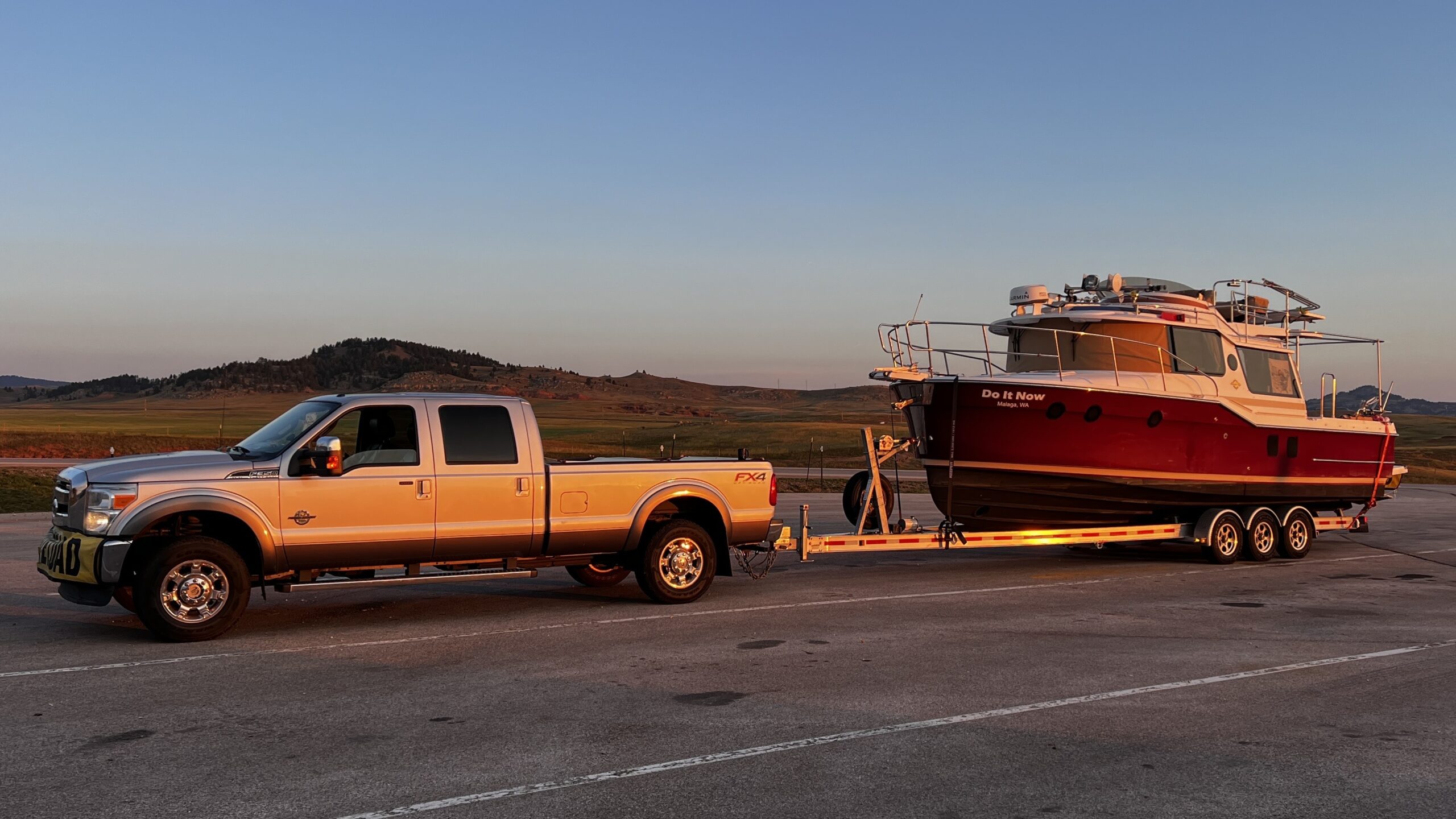
I parked overnight at a really nice rest stop.
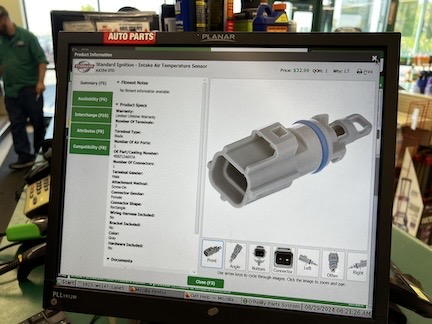
This is the part that caused the Check Engine light to come on.
On Day 3, I hunted down a place that could read the code for the check engine light. It was an air intake temperature sensor. I was at O’Reilly and bought the part for $30. They gave me instructions on replacing it, but I didn’t feel comfortable doing it myself. I tried a Ford dealer and another car fixit place in Sheridan, WY but neither one was willing to do the 10 minute job without making me wait at least two weeks. Jeez! I continued on my way.
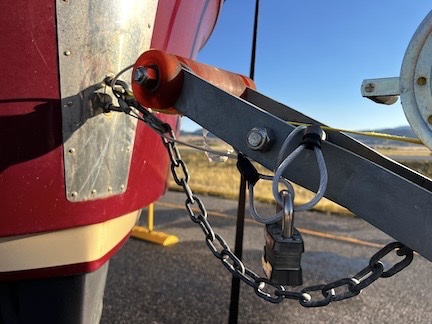
This boat lock is a bad joke.
I got to the Montana watercraft inspection station late in the day, still about 100 miles from that night’s destination. They found zebra mussels on my trim tabs. At least a dozen very tiny ones. They delayed me for more than an hour while they sprayed down the entire hull with hot water. Then they did something I considered ridiculous: they locked my boat to the trailer with a cable lock that any decent bolt cutter would cut right through.
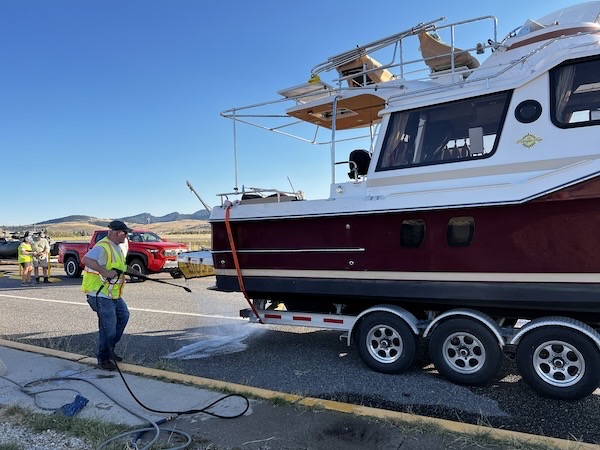
They washed down the hull of the boat with 140°+ water.
When they finally let me go, I was able to do another 25 miles before stopping at a truck stop for the night. I walked to the restaurant next door for an Asian chicken salad to go. When I got back to the boat, I discovered there was no dressing on the salad. It was that kind of night.
In the morning, I started before dawn. It was day 4 and I was eager to get to my destination at Des Moines, WA before 4 PM, so they could launch the boat before the holiday weekend. But it was not to be. I had two more watercraft inspection stations.
Idaho didn’t find anything and let me go after stamping Montana’s paperwork.
Thirty miles later, Washington’s crew found a few more mussels. They sprayed down the boat again. This was where things could get ugly; they had the power to force me to keep the boat out of the water for 30 days. I pointed out that the boat was going into salt water, which would kill any remaining mussels. Finally, after pouring hot water into my bilge (which the bilge pump eventually removed), they unlocked the boat and let me go.
But that time, there was no way I’d get to Des Moines before 4 PM. I rolled up at 5, unlocked the gate, and backed my rig in. I spent the night right there.
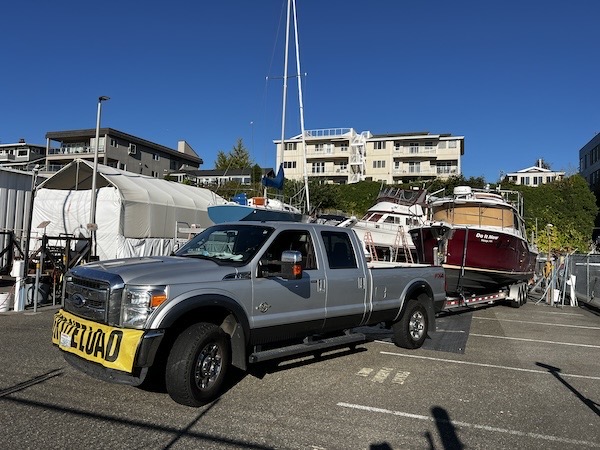
I parked for the night in the boatyard.
The Des Moines Fiasco
Because it was Labor Day weekend and I’d already seen the eastbound traffic the previous afternoon, I was in no hurry to get into Saturday morning traffic to get home. So I stayed at the marina and spent the entire morning reinstalling all my canvas, lines, fenders, and anything else I needed to get the boat ready to go. Finally, around 1 PM, I headed home, making a stop at Trader Joe’s along the way.
It was a three-hour drive, which actually seemed short after all the driving I’d been doing.
My house sitter was gone so I went right into my house. He’d left it pretty clean, although using the vacuum did not seem to be part of his clean up process. I didn’t care. There were clean sheets on the bed. I made myself some dinner and was asleep by 8 PM.
Did I mention I still tested positive for Covid?
I left home at 5 AM on Tuesday so I could get to the marina early enough to get the boat into the water. When I did some heavy braking in traffic near Seattle, that check engine light went off. (Go figure, huh?)
I stopped at a supermarket for provisions along the way.
I got to the marina right around 9:15 AM. I stopped in the office to tell them I was there and ask them to look at the damage on my bow.
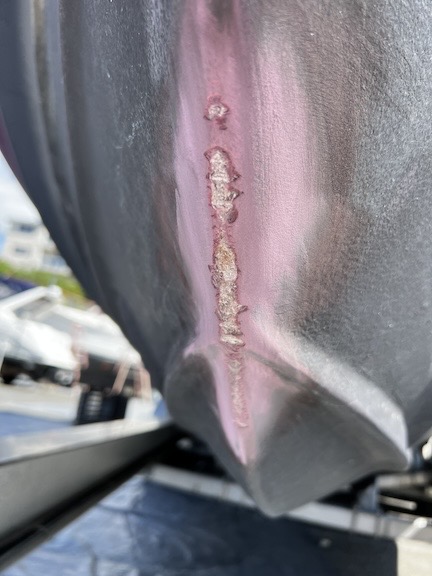
It cost me $300 to have the damage to the bow ground out (shown here) and then filled and painted. I have to give the worker credit, though. He did an excellent job.
They came out to look 2 hours later. They fixed the damage 3 hours after that. So now the boat had fresh paint beneath the waterline. They could not launch it that day. All thoughts of a quiet anchorage that night on my way to Roche Harbor evaporated.
As for my thruster battery, which I’d told them the week before needed replacing, they did not have the battery on hand and insisted on wasting time “diagnosing” the problem. I paid $350 for them to tell me I needed a new thruster battery. (Duh.) Then I paid more than $500 for the battery, which they did not have until noon the next day. So instead of launching my boat on Tuesday so I could have a nice, leisurely cruise from Des Moines to Roche Harbor — a distance of about 85 nautical miles — I had to haul ass out of Des Moines and run at top speed to get there before sunset on the same day.
And don’t even get me started on the vehicle parking issues at Des Moines. I had to get a special permit to park my truck and trailer for the 5 days I’d be cruising in the San Juan Islands. Normally, they don’t allow overnight parking at all.
I was very disappointed with CSR South services and the marina’s parking policy. I will not be back with my boat. I’ve already arranged for a one-way car rental from Anacortes to fetch my truck. I’ll use Anacortes as my base until it’s time to pull the boat out for the winter.
The only good news: I tested negative for covid on Tuesday morning.

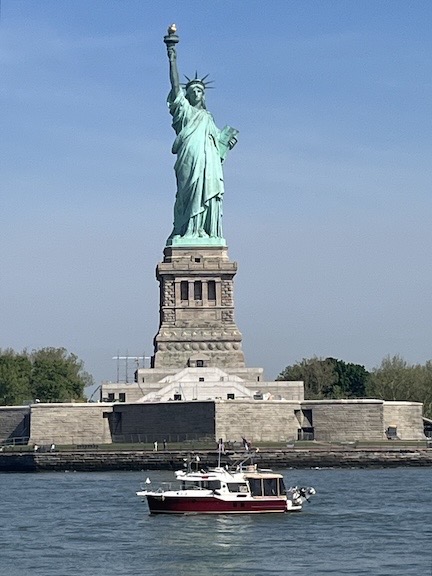
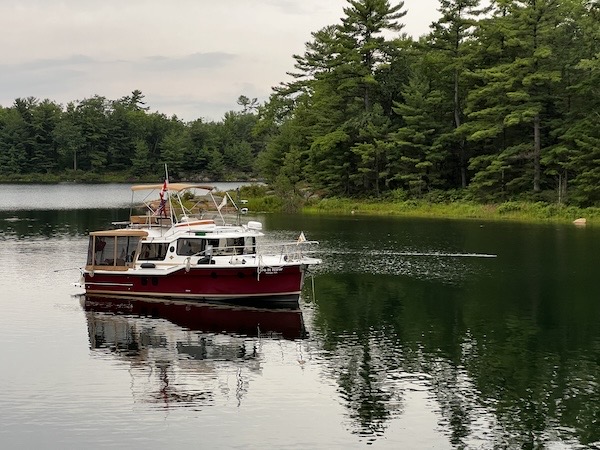
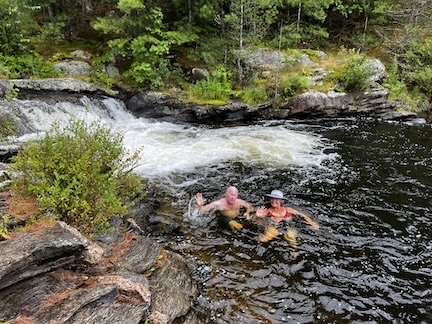
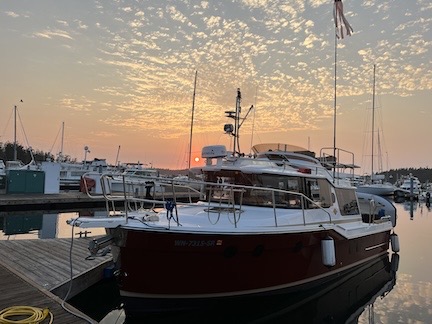
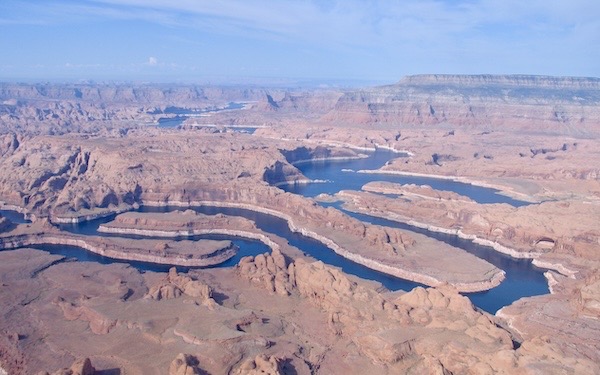
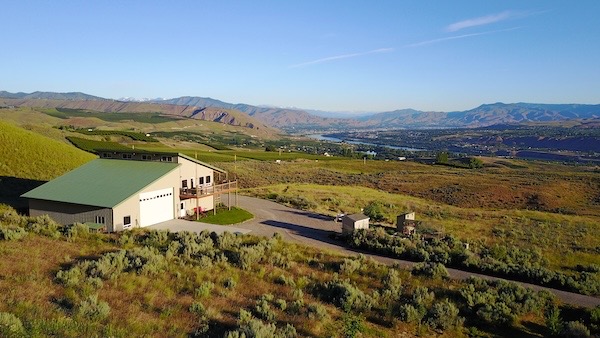
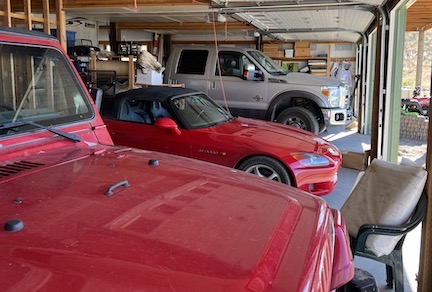
 This might be the only photo I have of my Honda and Toyota parked side by side. For years, the Toyota lived at whatever airport I flew my helicopter to most often: Prescott, Scottsdale, and, in this photo, at Phoenix Deer Valley.
This might be the only photo I have of my Honda and Toyota parked side by side. For years, the Toyota lived at whatever airport I flew my helicopter to most often: Prescott, Scottsdale, and, in this photo, at Phoenix Deer Valley.